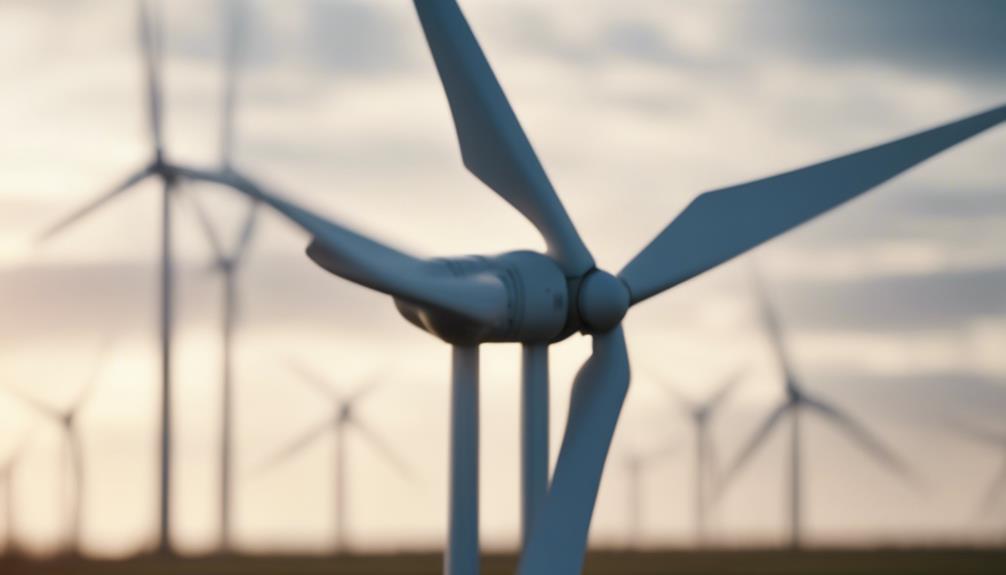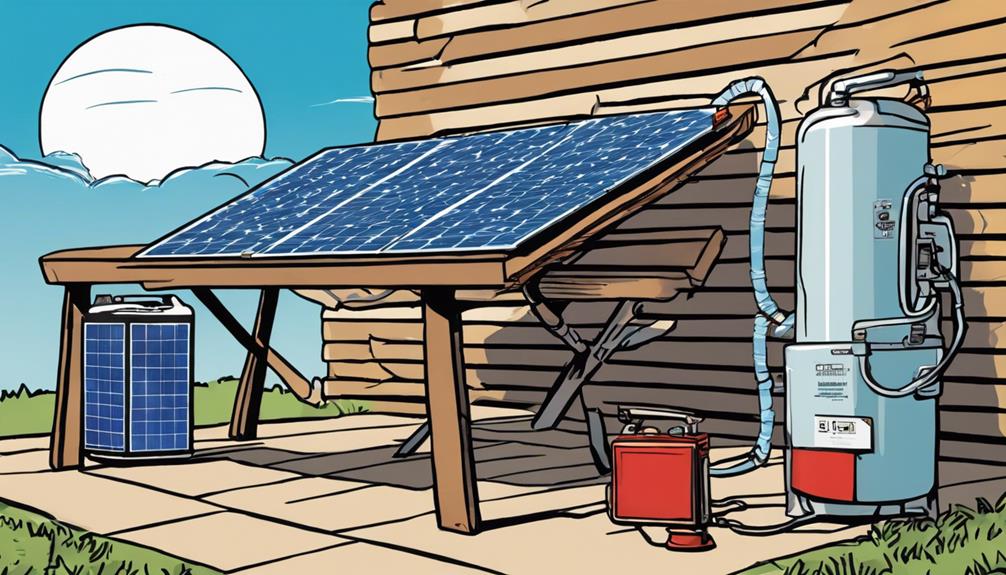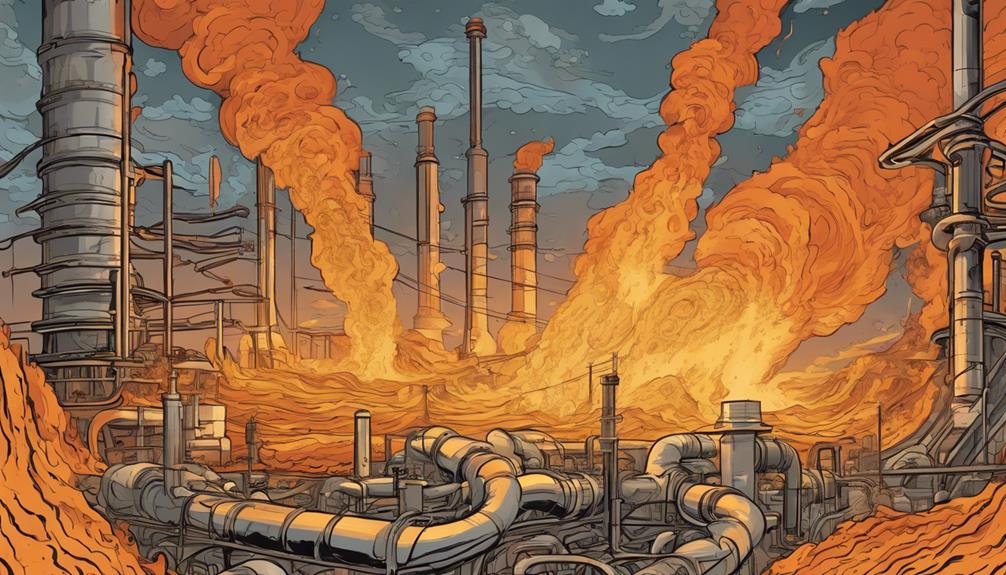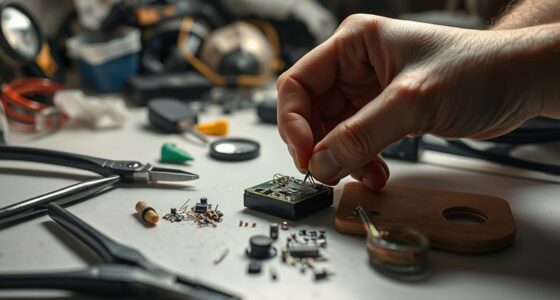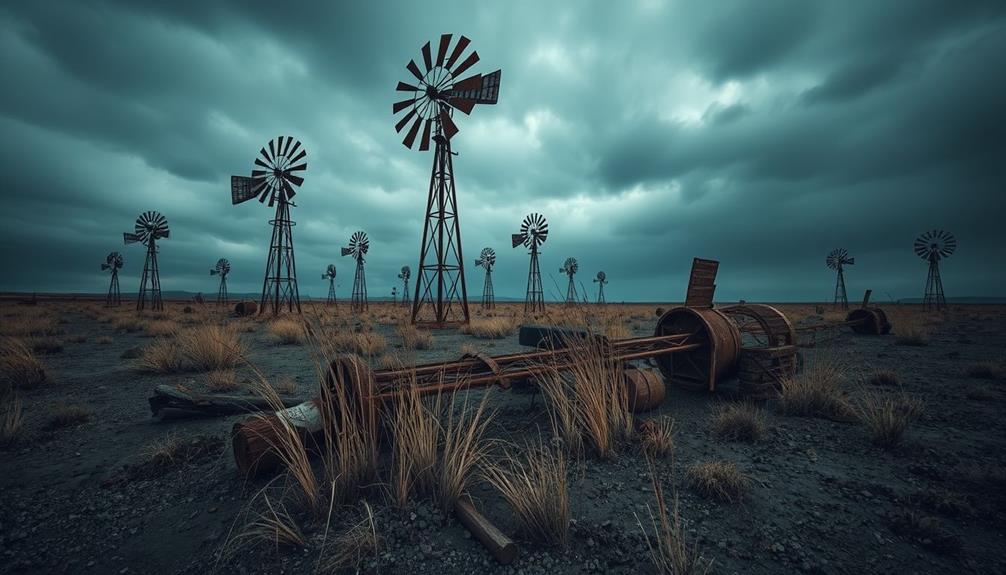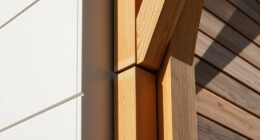The kinetic energy of the wind drives the generator in a wind turbine, converting it into electrical energy effectively. This mechanical energy gets transformed into electricity through the generator within the turbine. If you want to discover more about how wind turbines harness wind energy to generate power, you'll find insightful information on their operation and functionality in the details provided.
Key Takeaways
- Kinetic energy from wind drives the generator.
- Rotor blades capture wind energy for the generator.
- Aerodynamic forces cause blades to spin the generator.
- Wind's kinetic energy is converted to electrical energy.
- Mechanical energy from rotating blades powers the generator.
Wind Turbine Generator Basics
To understand wind turbine generator basics, understanding the role of the generator in converting wind energy into electricity is vital. Wind turbines harness the kinetic energy from their rotating blades to drive the generator.
As the wind turns the blades, they transfer this kinetic energy to the generator, which then converts it into electrical energy. This process involves the transformation of mechanical energy from the wind into usable electricity, making wind turbine generators essential components in the generation of renewable energy.
Wind Turbine Operation Mechanism
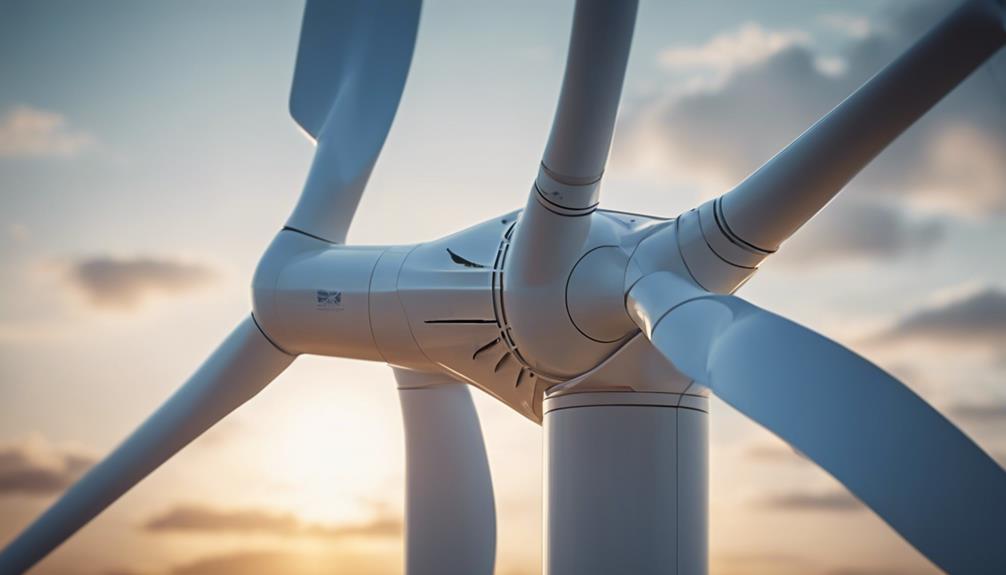
You know that wind energy is converted into electrical power through the operation of wind turbines.
The generator, powered by the spinning rotor blades, plays an essential role in this process.
As the wind causes the blades to rotate, the generator inside the turbine nacelle transforms this mechanical energy into electrical energy for consumption.
Wind Energy Conversion
The wind energy conversion process in wind turbines involves harnessing the kinetic energy of the wind to drive the rotor blades and generate electricity through the turbine's generator.
Rotor blades of a wind turbine capture the energy from the wind, causing them to spin due to the aerodynamic forces acting upon them. This rotational motion is then transferred to the generator, where it's converted into electrical power.
Wind energy conversion is the process where the kinetic energy of the wind is transformed into usable electricity by the wind turbine. The generator plays an essential role in this process by converting the mechanical energy from the spinning blades into electrical power.
As the rotor blades turn, they create rotational motion, which is then used to generate electricity, making wind turbines an efficient and sustainable source of renewable energy.
Generator Power Source
How does the generator in a wind turbine harness kinetic energy for power generation?
The generator power source of a wind turbine relies on the conversion of kinetic energy from the wind into mechanical energy through the rotation of the turbine blades.
This mechanical energy is then utilized to turn the generator, which is housed within the nacelle of the turbine.
As the wind causes the blades to spin, the generator rotor inside the nacelle also rotates, converting the mechanical energy into electrical energy.
This process is crucial for initiating electricity production in wind turbines.
Turbine Electricity Generation
Amidst the gusts of wind, the turbine blades of a wind turbine begin their rhythmic dance, harnessing the kinetic energy to power up the electricity generation process.
As the blades spin, they generate mechanical energy, which is then converted into electrical energy by the generator housed within the turbine's nacelle. This pivotal component plays a crucial role in the conversion of kinetic energy from the wind into usable electricity.
Wind turbines operate on the principle of electromagnetic induction, where the generator converts the rotational motion of the blades into electrical power. Through this process, wind energy is efficiently harnessed and turned into clean electricity for various applications.
The generator within the wind turbine is fundamental in enabling the sustainable generation of electricity from renewable sources, making it a key player in the shift towards greener energy solutions. By leveraging the power of wind, these turbines contribute significantly to the production of environmentally friendly electricity.
Wind Turbine Electricity Generation Process

As the wind propels the rotor blades to spin, kinetic energy initiates the process of generating electricity in wind turbines.
The kinetic energy from the spinning rotor blades is vital as it's converted into mechanical energy, which in turn drives the generator responsible for producing electricity.
Wind turbines rely on the principles of aerodynamics to harness wind energy efficiently.
Through the rotation of the blades, the mechanical energy is transferred to the generator's rotor, where it's converted into electrical energy.
This electrical energy generated can then be used to power various applications such as homes, businesses, or even stored for future use.
The generator in a wind turbine plays a significant role in transforming the wind's kinetic energy into usable electrical energy, making wind turbines an essential source of renewable energy in today's world.
Wind Turbine Generator Power Source

You should focus on the Wind Turbine Generator Power Source in this discussion.
The generator in a wind turbine is powered by kinetic energy from the spinning rotor blades.
This kinetic energy is then converted into electrical energy through a process involving mechanical and electromagnetic induction mechanisms.
Generator Power Source
The source of power for the generator in a wind turbine is derived from the kinetic energy harnessed by the spinning rotor blades. As the wind turns the blades, they accumulate kinetic energy, which is then converted into mechanical energy to drive the generator.
This mechanical energy is further transformed by the generator into electrical energy, providing a usable electrical power output. In wind turbine systems, two common types of generators are employed: synchronous generators and permanent magnet generators. These generators play an essential role in the wind turbine system, acting as the key component that facilitates the conversion of wind energy into electricity.
Wind Turbine Mechanism
Harnessing the kinetic energy from the spinning rotor blades, the wind turbine mechanism efficiently converts mechanical energy into electrical power through the generator.
As the wind flows through the turbine, the following occurs:
- The aerodynamic force from the wind causes the rotor blades to spin, propelling the rotor.
- The rotor, connected to a shaft, transmits the mechanical energy generated by the spinning blades to the generator.
- Inside the generator, electromagnetic induction principles are utilized to convert the mechanical energy into electricity, ready for transmission or local use.
The intricate dance between the wind, rotor blades, and generator is what enables wind turbines to harness wind energy and transform it into a sustainable source of electricity.
This mechanism showcases the ingenuity behind converting natural elements into a usable and renewable energy source.
Electrical Generation Process
Utilizing the kinetic energy generated by the spinning rotor blades, wind turbines power their generators to convert mechanical energy into electrical power. As the wind propels the rotor blades, the kinetic energy is transferred to the generator via the shaft.
Inside the generator, electromagnetic induction principles come into play, transforming the rotational energy into electrical energy. This process allows wind turbines to harness wind power efficiently and produce clean, renewable electricity.
The generated electricity is then passed through a transformer to elevate the voltage for effective transmission. Through this mechanical to electrical energy conversion, wind turbines play an essential role in sustainable energy production.
Wind Turbine Energy Conversion Details

Using aerodynamic principles, wind turbines efficiently convert wind energy into electricity through the generator's mechanical rotation. The wind turbine works by utilizing the kinetic energy produced as the wind turns the rotor blades, ultimately converting this kinetic energy into electrical power.
Here are three key details illustrating the wind turbine energy conversion process:
- The generator creates electrical power by converting the mechanical energy derived from the spinning rotor blades.
- The aerodynamic principles employed by wind turbines enable the efficient conversion of wind energy into electricity.
- The kinetic energy generated by the rotation of the rotor blades is essential in driving the generator to produce electrical power for distribution.
In essence, the mechanical rotation of the wind turbine's generator plays a fundamental role in transforming the natural force of the wind into usable electrical energy, highlighting the intricate process through which wind turbines harness renewable energy sources.
Wind Turbine Generator Functionality

In wind turbines, the generator functions by converting mechanical energy from the spinning blades into electrical energy. This essential component is typically housed in the nacelle along with the gearbox and controller.
Wind turbines commonly utilize synchronous generators or permanent magnet generators to produce electricity efficiently. To adapt to varying wind speeds, the generator operates at variable speeds, optimizing electricity production.
The output generated by the generator is usually in the form of alternating current (AC), which is then converted to direct current (DC) for grid integration or battery storage. By harnessing the power of the wind, these generators play a crucial role in transforming kinetic energy into a usable electrical form, enabling wind turbines to contribute significantly to renewable energy generation.
Wind Turbine Power Generation Explanation

The generation of power in wind turbines relies on converting the kinetic energy of the rotating blades into electrical energy. When the wind blows, it causes the blades to spin, transferring this motion through a shaft to a generator.
The generator within the turbine then utilizes electromagnetic induction to transform the mechanical energy from the rotating blades into electrical energy. Here's how it works:
- The wind turbines catch the force of the wind and set the blades in motion.
- The spinning blades turn a shaft connected to a generator housed within the turbine.
- The generator uses this rotational motion to produce electricity, converting the kinetic energy of the wind into usable electrical energy.
Through this process, wind turbines effectively harness the power of the wind to generate electricity, contributing to a cleaner and more sustainable energy source for various applications.
Wind Turbine Generator Operation Insights
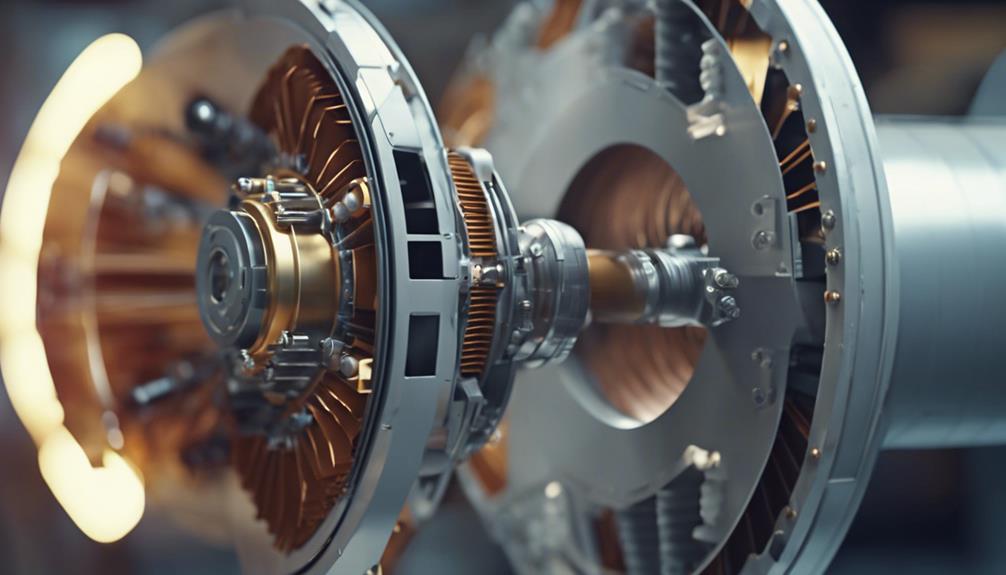
To understand wind turbine generator operation insights, consider the essential role of the generator in converting wind energy into electricity efficiently.
As the wind flows over the blades of the turbine, the blade creates both lift and pressure on one side, causing the rotor to spin. This rotation is critical as the rotor connects to the generator, which converts the mechanical energy from the rotor into electrical energy.
The generator, typically a three-phase synchronous generator, produces alternating current (AC) electricity for transmission. For best performance, wind turbine generators require sufficient wind speeds to start generating electricity efficiently.
Frequently Asked Questions
What Drives the Generator in a Wind Turbine?
You know what drives the generator in a wind turbine? The spinning rotor blades generate kinetic energy, converting wind energy into mechanical energy. This mechanical energy then powers the generator through the blades' rotation, producing electricity.
What Kind of Energy Does a Wind Turbine Use?
Wind turbines use kinetic energy from the wind. The energy turns the rotor, creating mechanical energy that powers the generator. This generator then produces electrical energy. Wind turbines efficiently convert wind energy into electricity for various uses.
What Type of Energy Is Involved When the Turbine Turns the Generator?
When the turbine turns the generator in a wind turbine, mechanical energy from the spinning blades is converted into electrical energy. This transformation enables the generation of electricity from the kinetic energy harnessed by the turbine.
What Type of Energy Relies on a Windmill Driving an Electric Generator?
You think it's magic, but it's science! When a windmill spins the generator, it's the kinetic energy from the wind doing the heavy lifting. That's what powers up the electrical magic inside!
Is the Energy Generated from Wind the Same as the Energy that Drives the Generator of a Wind Turbine?
Yes, the energy generated from wind is the same as the energy that drives the generator of a wind turbine. The kinetic energy from the wind is converted into electrical energy through the rotation of the turbine’s blades, which in turn powers the generator to produce electricity. This process is similar to energy generation from wind and solar.
Conclusion
As the wind spins the turbine blades, the generator inside comes to life, converting the kinetic energy of the wind into electrical power.
It's like a dance between nature and technology, with the wind leading the way and the generator following its every move.
Just like a skilled partner, the generator harnesses the wind's energy and transforms it into electricity, creating a beautiful harmony between nature's power and human innovation.
